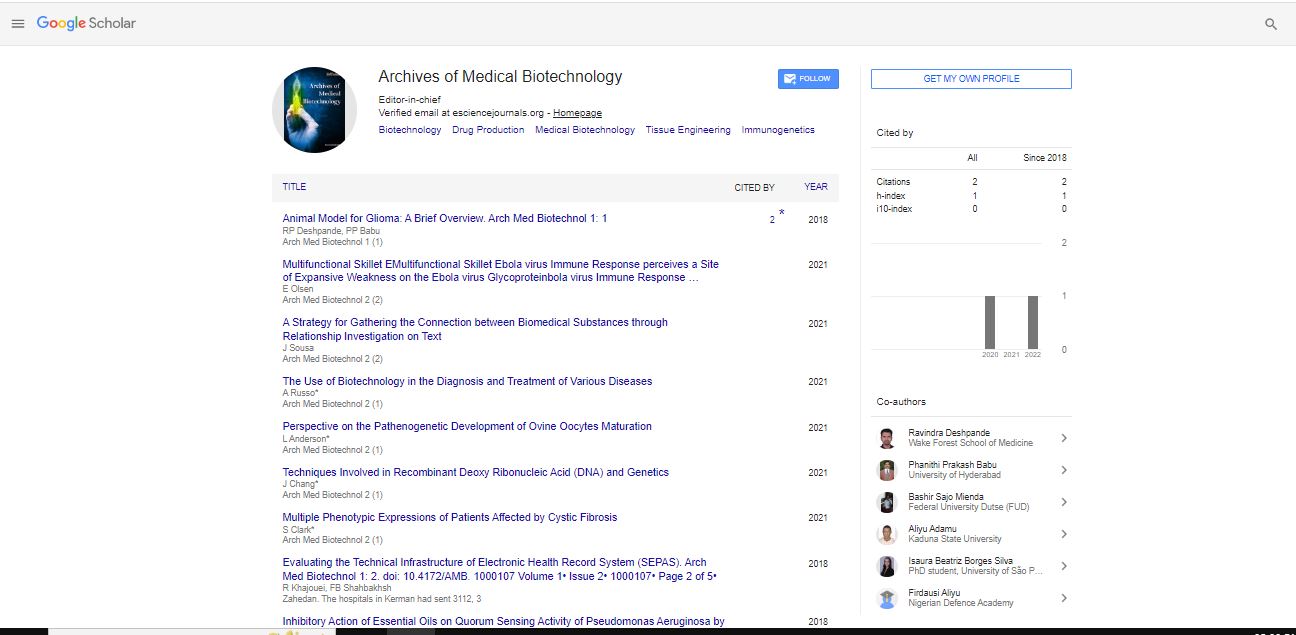Short Communication, Arch Med Biotechnol Vol: 2 Issue: 1
Multiple Phenotypic Expressions of Patients Affected by Cystic Fibrosis
Steven Clark*
Department of Respiratory and Sleep Medicine, Women's and Children's Hospital, North Adelaide, South Australia
*Corresponding Author: Steven Clark
Department of Respiratory and Sleep Medicine, Women's and Children's Hospital, North Adelaide, South Australia
E-mail: Steven.Clark@edu.au
Received: September 04, 2021 Accepted: September 18, 2021 Published: September 25, 2021
Citation: Clark S (2021) Multiple Phenotypic Expressions of Patients Affected by Cystic Fibrosis. Arch Med Biotechnol 2:1.
Keywords: Multiple Phenotyphe, Cystic Fibrosis
Introduction
Cystic fibrosis (CF) is a latent hereditary illness that is brought about by transformations on both CFTR alleles, bringing about strange perspiration electrolytes, sino-pneumonic sickness, male barrenness, and pancreatic exocrine inadequacy in 95% of patients. In its exemplary structure, the infection is effortlessly analyzed right off the bat throughout everyday life, through a blend of clinical assessment and research facility testing (counting sweat testing, and CFTR transformation investigation). Contingent upon the ethnic foundation of the populaces tried, normal hereditary transformations are distinguished in most of instances of CF [1]. In the USA, 66% of patients convey something like one duplicate of the transformation, with roughly half of CF patients being homozygous for this change. A wide range of atomic irregularities might happen in the CFTR quality, and phenomenal transformations that outcome in incomplete (lingering) CFTR capacity might be related with nonclassic introductions of illness. Generally speaking, 7% of CF patients are not analyzed until age 10 years, with an extent not analyzed until after age 15 years; a portion of these patients present an impressive test in setting up a conclusion of CF. In addition, the aggregate in these patients might shift widely. The focal point of the current audit is on neoclassic aggregates related with changes in the CFTR quality, which might show as male barrenness (inborn reciprocal shortfall of the vas deferens (CBAVD)), gentle pneumonic infection and idiopathic constant pancreatitis (ICP). These aggregates are incorporated inside the meaning of 'abnormal CF.
Cystic Fibrosis Trans Membrane Regulator (CFTR)
CFTR is a transmembrane spreading over protein with different exercises that are identified with typical epithelial cell function. Mutations in CFTR bring about irregularities in epithelial particle and water transport, which are related with disturbances in aviation route mucociliary leeway and other cell capacities identified with ordinary cell biology [2]. Depending on the atomic anomaly, the deformity in CFTR might be what could be compared to that related with a 'invalid' transformation, or might be 'gentle', with fractional/ remaining capacity. Toward one side of the range of seriousness, 'invalid' or 'extreme' transformations reflect garbage, outline shift or raft changes; these outcome without creation of useful CFTR, which corresponds unequivocally with pancreatic exocrine deficiency, however less firmly with seriousness of lung illness. At the opposite finish of the range, 'gentle' changes might bring about some creation of practical CFTR protein at the apical layer, with incomplete CFTR channel work, and are by and large connected with pancreatic adequacy and milder pneumonic sickness [3]. The atomic reason for the seriousness of transformations might get from the degree to which ordinary mRNA record or protein amalgamation happens; for instance, join changes might impact the proficiency of typical/strange CFTR mRNA record to shifting degrees. Thus, the seriousness of the irregularity in CFTR might relate straightforwardly to the phenotypic articulation of infection, with missing capacity causing more extreme illness, while some remaining capacity might balance the seriousness of sickness in various organ frameworks. Clinically, this might be reflected in ordinary or marginal perspiration chloride esteems in patients with abnormal CF [4]. Other factors, including non-CFTR quality modifiers and ecological impacts, are likely likewise connected with the seriousness of illness. Given this foundation, it isn't shocking that illness articulation is perplexing and that neoclassic CF aggregates exist.
Heritability of Clinical Phenotypes
Before broad hereditary information was accessible, the overall idea was that the heterogeneity of clinical aggregates reflected contrasting extents of hereditary versus ecological influences.For model, obstructive azoospermia (inborn reciprocal shortfall of the vas deferens, CBAVD), happens in virtually all CF guys, whether or not the CFTR change has some leftover capacity, or not; in this way, CBAVD is dictated by hereditary qualities fundamental transformations in CFTR (Cutting 2010). CF-related diabetes (CFRD) and serious CF liver illness with gateway hypertension (CFLD) is restricted to patients with two CFTR changes without lingering function [5]. CFLD happens before adulthood in by far most of CF patients who foster CFLD. The commonness of CFRD is age-subordinate, and happens in ∼25%–35% of CF grown-ups. Lung infection happens in patients whether or not CFTR changes have remaining capacity, or not, however the scope of illness seriousness is exceptionally extraordinary; subsequently, there are possible significant commitments from both non-CFTR hereditary modifiers and natural impacts.
References
- Welsh MJ, Ramsey BW, Accurso FJ, Cutting GR (2001) Cystic fibrosis. The Online Metabolic and Molecular Bases of Inherited Disease 5121-5188.
- Wood SD, Adams S, Dunn J, Baler R, Xu A (2007) Inaccuracy of reporting of meconium ileus on case report forms of the gene modifier study. Pediatr Pulmonol Suppl 30: 272.
- Green DM, Collaco JM, McDougal KE, Naughton KM (2012) Heritability of respiratory infection with Pseudomonas aeruginosa in cystic fibrosis. J Pediatr 161(2): 290- 5.
- Faria EJ, Faria IC, Ribeiro JD, Ribeiro AF (2009) Association of MBL2, TGF-β1 and CD14 gene polymorphisms with lung disease severity in cystic fibrosis. J Bras Pneumol 35: 334-342.
- Drumm ML (2001) Modifier genes and variation in cystic fibrosis. Respir Res 2: 125-128.
 Spanish
Spanish  Chinese
Chinese  Russian
Russian  German
German  French
French  Japanese
Japanese  Portuguese
Portuguese  Hindi
Hindi 